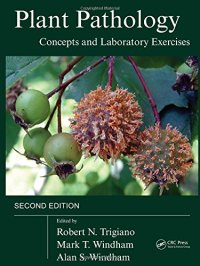
Ebook: Plant Pathology Concepts and Laboratory Exercises, Second Edition
Author: Robert N. Trigiano
- Tags: Reference Test Preparation Almanacs Yearbooks Atlases Maps Careers Catalogs Directories Consumer Guides Dictionaries Thesauruses Encyclopedias Subject English as a Second Language Etiquette Foreign Study Genealogy Quotations Survival Emergency Preparedness Words Grammar Writing Research Publishing Crop Science Agricultural Sciences Math Horticulture Entomology Biology Biological Botany Life Mathematics New Used Rental Textbooks Specialty Boutique Zoology Agriculture
- Year: 2007
- Publisher: CRC Press
- Edition: 2
- Language: English
- pdf
Revised and updated with new concepts, case studies, and laboratory exercises, Plant Pathology Concepts and Laboratory Exercises, Second Edition supplies highly detailed and accurate information in a well-organized and accessible format. New additions to the second edition include five new topic and exercise chapters on soilborne pathogens, molecular tools, biocontrol, and plant-fungal interactions, information on in vitro pathology, an appendix on plant pathology careers, and how to use and care for the microscope. An accompanying cd-rom contains figures from the text as well as supplemental full-color photos and PowerPoint slides.
Unique Learning Tools
Retaining the informal style of the previous edition, this volume begins each topic with a concept box to highlight important ideas. Several laboratory exercises support each topic and cater to a wide range of skill sets from basic to complex. Procedure boxes for the experimental exercises give detailed outlines and comments on the experiments, step by step instruction, anticipated results, and thought provoking questions. Case studies of specific diseases and processes are presented as a bulleted list supplying essential information at a glance.
Comprehensive Coverage
Divided into six primary parts, this valuable reference introduces basic concepts of plant pathology with historical perspectives, fundamental ideas of disease, and disease relationships with the environment. It details various disease-causing organisms including viruses, prokaryotic organisms, plant parasitic nematodes, fungi, plant parasitic seed plants, and other biotic and abiotic diseases. Exploring various plant-pathogen interactions including treatments of molecular attack strategies, extracellular enzymes, host defenses, and disruption of plant function, the book presents the basic ideas of epidemiology, control strategies, and disease diagnosis.